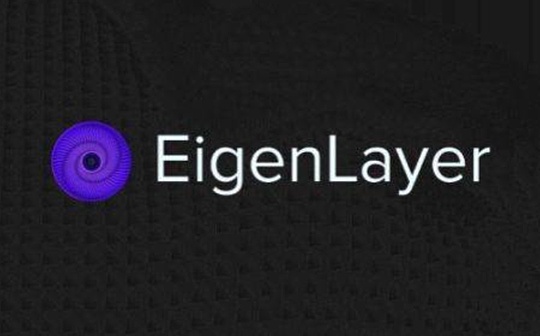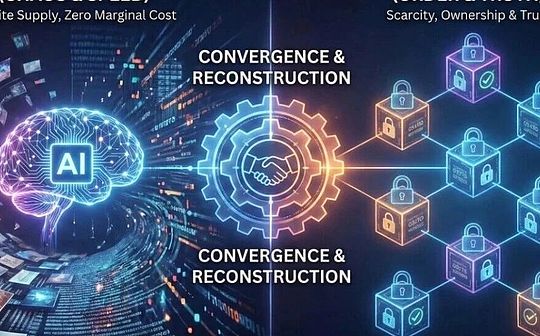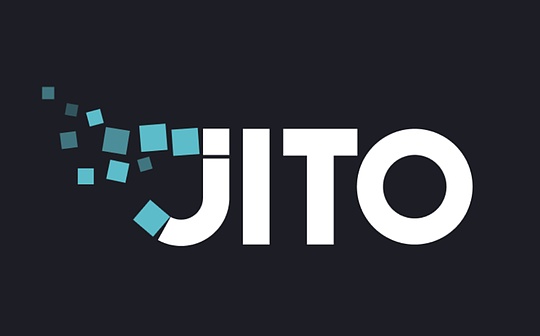
Author: Paul Timofeev, Sitesh Kumar Sahoo, and Gabe Tramble
Source: Shoal Research Translation: Shan Oppa, Bitchain Vision
introduction
The rapid development of the Web3 field stems from its open source and decentralized features.This feature brings over-growth and scale expansion, what many call cryptographic composability.This composability allows the creation of a modular technology stack where components can be seamlessly embedded or removed, driving unprecedented innovation.At the heart of this innovation, it is the basic process of blockchain transactions, and its core value depends on the ability of distributed networks to coordinate and achieve consistency in system state.
When sending transactions on a blockchain, a distributed node network must first verify the transaction content and then vote on the order of transactions to form the next block to be added to the chain.When these nodes reach an agreement, a state called “consensus” is reached.Blockchain initially used a Proof-of-Work (PoW) mechanism to achieve consensus, which involves professional node competition called miners to solve encryption problems in order to add new transactions and blocks to the chain.
Although Bitcoin and many blockchains still use the PoW consensus, most blockchains have turned to Proof-of-Stake (PoS) today, ensuring security through economic incentives rather than computing power.This concept was first proposed in the 2012 Peercoin white paper, and a deterministic algorithm was proposed to select nodes based on the number of local network tokens pledged by node operators, and prefer nodes with more capital.
Later, Jae Kwon wrote the Tendermint BFT white paper in 2014, introducing a new consensus mechanism that can reach consensus as long as less than one-third of the nodes fail, and in 2019, along with the Cosmos Hub main networkto be put into use when starting.In addition to consuming significantly less energy than PoW, a key advantage of PoS is that, like PoW, staking cannot be easily forged.In addition, PoS motivates honest behavior through a process called “slashing” that will suffer financial losses if validators have malicious behavior.
With the widespread adoption of PoS blockchain, participation in staking has spawned new ideas for maximizing the utility of staking capital, such as making staking capital more liquid, in order to provide security for new products and ecosystems.
Overview of pledge design
Original pledge
Staking is a mechanism in which token holders deposit tokens into staking contracts to participate in the security maintenance of the underlying protocol and receive rewards through contributions.In this article, this mechanism may be referred to as “primitive staking” because its core utility is limited to staying idle in smart contracts, while other forms of staking provide additional utility, which will be further expanded below.The staking scale of a validator determines the possibility of being selected for production blocks. The more pledged capital, the greater the possibility of being selected.Technically, anyone can participate as an independent stakeholder, but blockchains usually impose certain financial and hardware requirements on stakeholders, which may not be easy for ordinary users or token holders.For example, participating Ethereum validators need to deposit 32 ETH and be equipped with at least 16GB of RAM, multi-core CPU, and 1TB SSD, while Solana needs to pay 1.1 SOL per day to vote and be equipped with at least 256GB of RAM, fast multi-core CPU, and high-speed SSD storage.
Therefore, in order to lower the threshold for participation, a delegation mechanism was formed so that token holders can participate in staking with less capital without any hardware, while allowing node operators running verifiers to expand their staking allocations, thereby increasing their blocksaward.Pledge can be directly entrusted to the verifier or entrusted through the staking pool. The staking pool is a smart contract that centrally entrusts funds to multiple verifiers.The staking pool can be hosted by a third party (such as the centralized exchange CEX that provides staking services), or unmanaged operations can be performed through decentralized on-chain protocols such as Rocket Pool on Ethereum or Jito on Solana.
Staking also exists at the application level, i.e. the token holder of the application can lock its tokens to ensure the security of the protocol (for example, providing liquidity when a loan agreement is deficient), which can usually bring to the staker.Rewards, as well as additional utility, such as governance rights or income sharing.This even gave birth to a bribery market in DeFi (such as Curve Wars), where competition among protocols accumulates more governance rights tokens, thereby achieving a higher percentage of reward returns.
Nevertheless, the original staking has a key limitation due to the simplicity of its design: the capital locked in the staking is non-liquid, thus reducing the liquidity of the tokens and their ecosystems.The lack of basic staking utility hinders the adoption of staking services, as rewards allocated token holders need to compensate for the risk of price exposure brought about by locking tokens.A large number of network activity may incur sufficient fees to provide natural returns to stakeholders, but this is often difficult to sustain and has not been historically true in most PoS chains.Allocation of rewards through local token is a common alternative, but over the longer term, it is equally difficult to sustain.This issue has prompted the development of liquidity pledge agreements.
Liquidity pledge
The emergence of liquid pledges stems from the need to develop a new mechanism to enable pledges to maintain the liquidity of their pledged assets without affecting the security of the underlying protocol.This process is largely similar to basic pledges, where the pledgee deposits assets into smart contracts and obtains basic gains from its contribution to the underlying system.However, liquid staking goes a step further, and it distributes a voucher token called Liquid Staking Token (LST) to the staker, whose value is equivalent to the original deposit.This innovation demonstrates the importance of composability in the DeFi field, as LST can be used in a variety of applications (e.g. liquidity provision, borrowing and lending), ultimately enabling stakeholders to obtain higher returns on the basis of staking assets., while increasing the overall liquidity of the underlying network ecosystem.
Since the first batch of liquid staking agreements emerged at the end of 2020, liquid staking has become the fastest growing area in DeFi.As of this writing, the space has exceeded $42.3 billion in assets, about 60% of which belong to Lido Finance’s stETH contracts.Currently, Ethereum accounts for nearly 85% of liquid staking assets in the DeFi field, while Solana is relatively small, with less than US$4 billion locked in liquid staking agreements, of which 45% comes from Jito.
Overall, liquid staking brings great flexibility and capital efficiency to stakers, which in turn benefits the underlying blockchain they support and the ecosystem built on it.However, with the development of blockchain, the use of pledged assets is also constantly evolving.The rise of modular infrastructure and services has spawned a large number of new application-specific blockchains that often face difficulties in building their own validator networks due to lack of activity and economic incentives.Therefore, new mechanisms are designed to expand the use of pledged assets, thereby helping the new blockchain to achieve security and launch.This mechanism is “restaking”.
Re-pled
Re-staking refers to extending a blockchain’s staking and validator network to provide security for any number of other blockchains.From a more formal perspective, restaking can be defined as a variant of shared security in a Proof of Stake (PoS) blockchain environment, where the security provision chain provides services to the security consumption chain, usually through a termImplementation of the re-pled agreement.
This mechanism enables new blockchains, whether specific application chains or general-purpose chains, to activate their security by leveraging the economic and computing resources of large-scale underlying layers such as Ethereum or Solana.Stakers can also increase capital efficiency by protecting multiple blockchains rather than single chains, thereby increasing the returns on pledged assets.However, it should be noted that protecting multiple blockchains will increase the slashing risk of pledged assets – a concept that will be further discussed later.
Like running the verifier node directly on the proof-of-stake blockchain or depositing funds into the staking pool, anyone can participate in restaking.Users can chooseNative re-pled(native restaking), that is, running a validator node that promises to participate in the restake module, or selectingLiquidity re-pled(liquid restaking), that is, pledged through an agreement or service provider, and the latter will re-polize on behalf of the user.In addition, re-private can be limited to native layer one (L1) assets, or can be extended to support almost any asset, which is called “general re-private” or “universal re-private”.
Early implementation
Although restaking is often associated with Eigenlayer today, the concept has been tested and implemented in application-specific blockchains, where launching security is often one of the biggest challenges.Several different ecosystems and networks have implemented some form of shared security at different times, and although specific details may vary, the core concepts tend to be the same – enabling smaller protocols to leverage existing economiesand computing resource pools to help their early development while improving the capital efficiency and returns of stakeholders.
• existPolkadotIn the ecosystem, validators participate in the security guarantee of the relay chain (Relay Chain) by pledging DOT, and the relay chain provides security for approved parachains.
• existAvalancheIn the network, validators who protect C chains (main centers of economic activities) can participate in the subnets, a collection of dynamic validators, cooperate to protect multiple chains or reach consensus on their status.Subnets can protect multiple chains, but each chain can only be verified by one subnet.
•CosmosTaking a different approach, the top 95% of its ecological center Cosmos Hub’s collection of staking weights and validator are actually copied to all consumer chains, a mechanism called “Replicated Security”.Cosmos Hub validators must run nodes on all consumer chains, although different software and/or hardware can be used.Cosmos Hub verifiers are penalized if validators perform poorly on the consumer chain (such as downtime or double sign-up).
In March 2023, replication security was officially launched through the Prop 187 V9 Lambda upgrade.However, the trend is gradually providing greater flexibility to stakeholders and validators.ICS v2 introduces “option-in security” that allows validators to choose whether to protect a specific consumer chain.Additionally, a proposal was proposed in early May 2024 that, if passed, would allow Cosmos Hub validators to receive BTC staking through the Babylon staking protocol, allowing any asset to be used for economic security on Cosmos.
Mesh Security will eventually allow chains to provide and use security simultaneously, rather than protecting consumer chains using the validator set of provider chains.The operator can choose whether to run the Cosmos chain, while the staker can choose to re-stake their pledged assets to protect another Cosmos chain.Finally, a proposal, released in early May 2024, will allow Cosmos Hub validators to receive BTC stakes through the Babylon staking protocol, paving the way for economic security using any asset on Cosmos.
In June 2023, the Eigenlayer protocol introduced the restake function to Ethereum.EigenlayerThe protocol is a set of middleware smart contracts on Ethereum that supports restaking ETH on the consensus layer, thus providing security for consumer chains called Active Verification Services (AVS).Eigenlayer ultimately acts as an open market to connect AVS seeking to lease security (verifier sets and/or staking assets) with stakers and node operators that provide the security mentioned above.ETH and supported ETH LSTs can be staked through a set of smart contracts that represent AVS extensions orRe-private economic security.
By renting secure assets to AVS, operators and stakeholders can expand the utility of their assets, thereby increasing returns.However, this also has risks, as their staking is now subject to any cuts that AVS may implement, in addition to being cuts by the underlying chain Ethereum.Eigenlayer is an off-protocol solution on Ethereum, which means that Beacon Chain validators can choose to participate as the Eigenlayer node operator.
Currently, there are no mandatory cuts or restake rewards on Eigenlayer, but this will change after the EIGEN token is available in late September 2024.Additionally, Eigenlayer recently announced permissionless token support to enable any ERC-20 token to be used as a re-stakeable asset.
General re-pled
Universal Restaking, or “universal restaking”, uses an asset-independent approach to allocate security resources from a group of providers to a group of consumers.This approach allows the convergence of various pledged assets on multiple chains, improving access to participants, and reducing dependence on a single underlying layer.Similar to Eigenlayer, the universal restaking protocol acts as an intermediate layer between the secure provisioning chain and the consumer chain (AVS).
Liquidity re-pled
Liquid re-pending enables re-pending assets to be expressed in the form of liquid re-pending tokens (LRT).The ultimate goal of liquidity pledge and liquidity re-pled agreement is similar: to provide liquidity representations of their base positions for re-pledgeers and pledgeers.Therefore, LRT can be formally defined as a derivative asset for re-pending positions.The LRT provider is ultimately responsible for portfolio management on behalf of the reprivator, managing the allocation of pledges in various income positions to maximize returns and minimize depositor risks.For more detailed LRT resolution, see the report published by Shoal Research.
The current situation of re-pled
As of this writing, the total amount of active re-pending assets has reached$28.14 billion.Among them, Eigenlayer accounts for the total amount60%, Ethereum accounts for the total re-staked TVL (total locked value)80%.So far, onlyEigenlayer, Babylon, Symbiotic and KarakThe TVL with four re-staking agreements has broken through$1 billion.
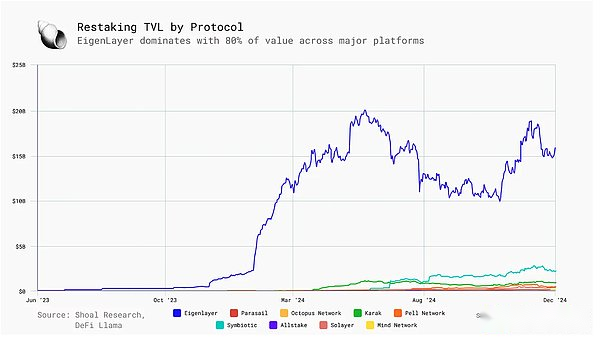
At the same time, the liquidity re-pled agreement has also grown rapidly with the development of re-pled, and its total TVL has reached approximately$15.62 billion, accounting for the total TVL re-pending appointment57%.
Compared with re-staking, the competition for liquidity re-staking is more intense, with different agreements taking turns to take the lead in the market since June 2023.As of this writing,EtherFiAccount for all liquidity replenishment deposits50%, and most of the liquid restaking TVLs are concentrated in Ethereum, which is consistent with the overall trend of restaking.
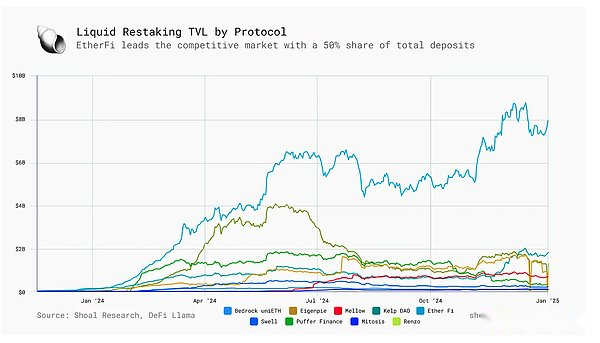
On Solana, re-staking development is slower:Picasso NetworkThe first re-private vault was launched on Solana at the end of January 2024, and it has attracted3,507 SOL(about$729,000) deposit.As of now, the total restaked TVL on Solana is approximately$371 million, most of which have been withSolayerThe launch of the increase.
Currently, withJitoEntering the market through its Jito (Re)staking agreement, restaking on Solana began to heat up.
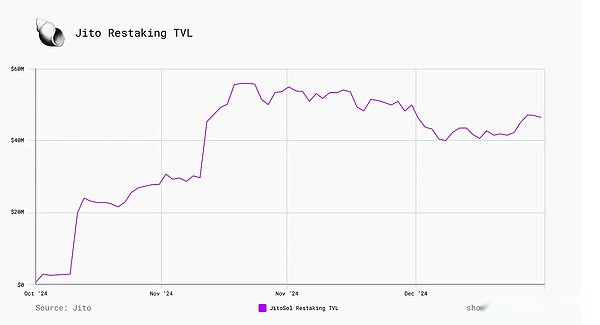
Re-pled on Solana
Built from scratch, Solana has a unique architecture that optimizes low-cost transactions at fast execution speeds and high transaction volumes.Solana aims to maximize the developer and user experience by leveraging the hardware performance capabilities, ultimately making hardware the only long-term limiting factor in network performance.As the second-ranked chain for TVL (total locked value), the re-staking ecosystem on Solana has the potential for growth and change in the medium and long term in the future.Jito is one of the teams looking to introduce restaking into the Solana ecosystem and leverage its successful product development history.
Introduction to Jito
Jito LabsFounded in 2021 by Lucas Bruder and Zano Sherwani, it is a US-based Solana infrastructure company that offers a suite of MEV (Maximum Extractable Value) products and services.Jito Labs is the core development team focusing on product development and deployment, andJito FoundationResponsible for JTO token governance and Jito network products and services (e.g.JitoSOL liquid staking tokensandJito (Re)staking Re-staking Agreement) strategic supervision.
In July 2022, Jito Labs first launched the MEV dashboard to help reveal the MEV ecosystem on Solana, which was not yet explored in depth.A few months later, the team was open sourceJito-Solana, this is the first validator client on Solana designed to capture MEV profits and redistribute them to validators and stakers.Jito-Solana ended up forking on the Solana Labs client, adding about 1000 lines of code to enable validators to get MEV rebates.Its broader goal is to combat spam and optimize Solana’s performance.
To cooperate with the client,Jito Block EngineSupport off-chain block space auctions, and searchers submit transaction lists executed in sequence and atomic manner (i.e.Transaction package).After simulated each transaction combination in the submission package, the engine forwards the highest paid transaction packet to the leader for inclusion in the block.Jito RelayerAs a transaction processing unit (TPU) proxy, transactions are filtered off-chain and validated and verified transactions are submitted to the block engine and validator.
It should be noted that in March 2024, Jito Labs announced the suspension of Jito Block Engine’s memory pooling capabilities, as the Solana ecosystem expressed concerns about some users running MEV robots using memory pools for sandwich attacks.Currently, Block Engine is still running and continues to process and forward transactions, and transaction package simulation is performed at the same time, but the memory pool component has been removed.
This mechanism ultimately imposes costs on network spam and performance barriers.Validators running Jito-Solana capture MEV profits generated in transaction packages during their leadership period.JitoSOL liquid staking tokensThe introduction of the stakeholder enables stakeholders to delegate stakes to validators running Jito-Solana clients, increasing the amount of stakeholders and enabling stakeholders to earn MEV rewards while gaining the underlying stakeholder.In December 2023, Jito Foundation also launchedStakeNet, This is a network of on-chain guardians and hypervisors, providing two core functions:
1.Verifier History Program: Stores up to 3 years of history of each validator in the entire network;
2.Guardian Program: Calculate scores based on the validator performance and manage staking allocations to ensure that staking is entrusted to the best performing verifier.
Based on its experience in MEV and liquid staking infrastructure services, Jito is introducing a new framework that enables applications and networks to leverage any SPL tokens on Solana for security.
Jito (Re)staking
On July 25, 2024, the Jito Foundation releasedJito (Re)stakingCode, which is a hybrid multi-asset staking protocol on Solana, allows any new network or application to boot its economic security.The protocol consists of two main components:
•Vault Program: Used to create and manage pledged assets;
•(Re)staking Program (re-staking program): Coordinate activities and incentive mechanisms among network participants.
Together, these two core programs provide developers with a modular and extensible framework to simplify the pledge mechanism of any SPL asset, becoming the first such protocol on Solana.
Before digging into it, here are some brief descriptions of some important terms:
•Node: refers to software that runs in accordance with its associated network specifications.
•Node Consensus Network (NCN): A set of distributed nodes that jointly realize consensus and provide services for specific protocols or networks, including L1 public chains, application chains, cross-chain bridges, coprocessor networks, DeFi applications, solver networks and oracle networks.
•Operator: The entity that manages one or more nodes in the node consensus network.
•Vault Receipt Token (VRT): Derivative tokens representing the basic re-staked positions, similar to LRT (liquidity re-staked tokens).
In short, Jito (Re)staking provides economic security and improves liquidity and composability to NCNs by tokenizing staked SPL assets into VRT.NCN can configure pledge parameters, penalties and other economic incentive mechanisms according to their needs.
Vault plan
Vault Program is responsible for managing the creation and operation of Vault Receipt Tokens (VRT).Its core logic is: pledge a token and obtain derivative tokens representing the pledged liquidity position, which can be used to protect the underlying NCN.Jito (Re)staking allows any SPL asset or multiple SPL asset portfolios as underlying assets, allowing stakeholders to more effectively diversify their VRT positions, create a more balanced risk-reward portfolio, and use more widely in the Solana ecosystem.assets.
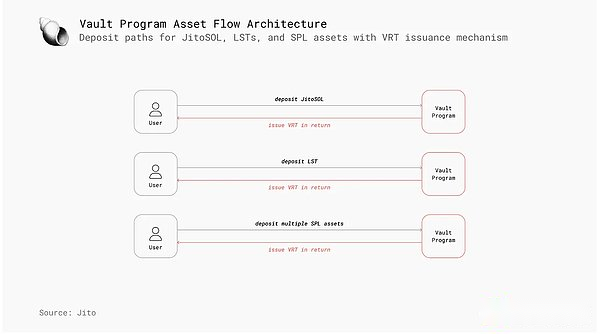
Vault Program allows NCN to manage the operations of VRTs (casting, destroying, commissioning) and enforce their own penalties and deposit/withdrawal caps.This is particularly important because not all SPL assets have the same security, and the security requirements and conditions of different NCNs may vary greatly due to differences in underlying functions.In addition, Vault Program allows NCNs to implement custom VRT delegation policies between multiple operators, DAOs, multi-signature, or on-chain automation protocols such as StakeNet Guardian Programs.
Re-staking procedure
While the Vault program manages VRT, the Restaking Program manages the NCN and its corresponding operators.This includes implementing various opt-in mechanisms, as well as managing the allocation and execution of cut conditions.
The Vault program and the restake program jointly create a modular framework that enables economic security using any SPL asset.Jito (Re)staking further simplifies the process for developers and NCNs, providing a simple and customizable interface to manage VRT and carriers.
Key Benefits of Jito (Re)staking
Jito (Re)staking aims to ease the cold start problem that is prevalent in the on-chain economy by providing NCNs with a modular, asset-independent framework to reach consensus and obtain economic security.
First, Jito (Re)staking allows anyone to create VRTs using any SPL asset, simplifying the design process of token economics and token utility; any token can become a liquid pledged or re-staked asset while maintaining governance compatibility.and execute the necessary safety parameters.In addition, Jito (Re)staking allows multi-asset stake, which means NCNs can also leverage existing assets with deeper liquidity and wider token distribution, as well as their native tokens, to achieve wider market access.
Another core advantage is that Jito (Re)staking allows NCNs to configure and fine-tune risk parameters.NCNs built on Jito (Re)staking can implement more complex risk management and security models to meet their specific needs, such as multi-layered penalties or multi-asset cuts to achieve deeper economic security.
Meanwhile, vaults, operators, and NCNs can choose the objects they integrate based on risk tolerance; vaults can choose the operators and NCNs to be entrusted, while operators and NCNs can choose the vaults and assets they want to support.The vault also has the option to include specific cuts determined by the NCN to better manage the number of assets at risk for a specific time.To ensure the security of users and assets, all program funds are securely stored in the Vault program and can only be extracted through user operations or cut event.
Roadmap and adoption
Since the launch of Jito (Re)staking, multiple teams and agreements have announced collaboration and integration plans:
•Switchboard– Decentralized oracle network on Solana Switchboard plans to enhance its economic security by leveraging multi-layered cuts and customizable staking parameters to improve the quality and performance of its data feeds.This will make the Switchboard the first node consensus network (NCN) to integrate Jito (Re)staking.
•Squads– Decentralized Treasury Management Protocol on Solana Squads Protocol is integrating Jito (Re)staking into its upcoming Squads Policy Network (SPN) to coordinate and motivate activities among network participants and improve reliability andperformance.SPN will provide more advanced digital asset management security and flexibility by enabling granular and universal trading strategies for smart accounts.
•Renzo– Renzo, the leading liquid restaking protocol strategy manager on Ethereum, will use Jito (Re)staking to launch its ezSOL as VRT.Anyone can mint ezSOL by staking JitoSOL and earn from a combination of pledge rewards, re-staking rewards, and MEV prompt income.
•Sonic– SVM Sonic, the first game on Solana, will integrate Jito (Re)staking in its upcoming HyperGrid shared state network and HyperGrid bridge.Jito (Re)staking’s NCN model will add an economic security layer to validators to safely prevent state conflicts in HSSN and enhance the core bridging infrastructure with multi-layered cuts and customizable staking parameters to enable atomicSVM ↔ Solana exchange.
•Fragmetric– Fragmetric has launched FragSOL, the first liquid re-staked token native to Solana as a VRT for Jito (Re)staking.FragSOL will utilize Solana’s token expansion capabilities to accurately allocate NCN rewards and introduce a standardized token program to effectively manage multi-asset staking and cuts.
•Ping Network (formerly Twilight)– Twilight, the upcoming privacy DePIN project on Solana, will leverage Jito (Re)staking to enhance the decentralization and economic security of its validator network.Twilight will leverage multi-level cuts and customizable staking parameters to ensure strong protection of its privacy infrastructure.
•Kyros– kySOL combines staking, MEV and restaking rewards into one token to optimize returns.Users can cast kySOL using JitoSOL or SOL.Kyros has also partnered with Jito, Kamino and Raydium to launch an incentive liquidity pool, which will enhance kySOL’s liquidity and open up more opportunities for the DeFi ecosystem.
Key risks and considerations
Before elaborating on Solana’s reasons for restaking (restaking) and evaluating Jito’s positioning, it is worth reviewing the key risks involved.Re-staking and liquidity re-staking introduce a series of interrelated risks that affect different participants in the ecosystem.
The core risks of staking blockchain
The core of the staking (Proof-Stake) blockchain is to provide security through slashing mechanisms.The reduction mechanism uses a penalty mechanism to punish validators who violate protocol rules (such as reviewing blocks) or those who perform poorly for a period of time (such as excessive downtime), confiscate some of their pledged assets.When this mechanism is applied to the restake protocol, the risk is further amplified because the operator is subject to additional reduction risks for any application or node consensus network (NCN) they protect.
Although this risk is compensated by providing higher returns to stakeholders and operators, its economic impact cannot be ignored under larger combined security adoption.The cut not only punishes validators, but also affects the stakers who delegate capital to them, resulting in a decrease in rewards received due to the reduction in stake.In restaking agreements, the more concentrated the distribution of pledges (i.e., most of the pledges are held by a small number of operators), the greater the overall risk of reduction.
This situation may affect the security of the underlying chain used to protect NCNs, especially if a large amount of stakes in the network are restaked and reduced, the cost required to control most of the network stakes may be reduced as a result.Price fluctuations in underlying assets also play an important role. The greater the price fluctuation, the higher the risks faced by the underlying protocol or NCN.
The lack of current reduction mechanisms
It is worth noting that most (if not all) re-pled agreements have not yet been launched.Therefore, the lack of deterrence against operators’ malicious behavior or poor performance poses greater risks to stakeholders and NCNs, especially participants with less capital resources and greater financial losses.
For example, some restaking protocols (such as Eigenlayer) have developed a framework for solving subjective failures—that is, problems that cannot be easily verified on the chain.Objective failures are applicable to violations that can be proven mathematically and cryptographically on-chain (such as double signing or long-term downtime), while subjective failures must be resolved off-chain through some social consensus among network participants.
Transparency and trust issues
This raises questions about the transparency and trust assumptions of these systems, and off-chain solutions can be complex and time-consuming processes that can even lead to base layer forking if there is enough controversy and disagreement around the correct state of the NCN.Eigenlayer plans to mitigate this risk by using EIGEN tokens, allowing validators to impose cuts on subjective failures and perform cuts by forking tokens rather than the underlying layer.
Impact of market-driven incentives
The impact of market-driven incentives on operators and stakeholders needs to be considered.To enhance the economic security of NCN, pledged capital must be sticky, i.e. remain stable over the long term.However, in the absence of some kind of long-term commitment through mechanisms such as lock-up periods (which in turn poses a risk to operators and stakeholders), operators may move their stakes at any time in pursuit of the highest possible returns.
Incentivizing NCNs to compete for operators by providing higher returns (usually inflationary token offerings) is not conducive to the broader ecosystem in the long run, and may instead repeat past mistakes in the design of crypto protocol incentive mechanisms (such as liquidity)Improving the income and expenditure in mining).
Key considerations for re-private liquidity
Shoal Research explored some of the key risks in liquidity restaking in a previous report, including:
•Supported deposit assets risk——Vault receipt tokens (VRT) bear the risk of their underlying assets.Local re-staked tokens and liquid staked tokens (LSTs) face different risks.
•Liquidity acquisition risk——Some re-staking agreements have a custody period when canceling the pledged assets (such as the 7 days of Eigenlayer).This mechanism raises concerns about maturity risks and potential liquidity issues.If the secondary market is insufficient liquidity, investors may find it difficult to sell VRT at fair market prices.Jito (Re)staking The cooling period for cancellation of pledge is approximately 4-5 days (two epochs).The time of asset redemption and liquidity of VRT providers play a key role in this risk.
•Smart contract risk——The risks of the VRT protocol architecture need to be evaluated, including reward allocation mechanism, fee structure and multi-signature permissions.These factors may affect asset transfer and withdrawal.
•Oracle risk——Reliable price data is crucial to maintaining VRT pricing.Inaccurate oracle data can lead to mispricing of VRTs, which in turn creates systemic risks during redemption or liquidation.
•Governance risks——The selection of mechanisms for how to protect NCNs is crucial in ensuring their long-term stability.A trade-off must be made between giving power to a large number of stakeholders (time-consuming) and granting to a minority of actors (such as 5/3 more sign-ups).
•Cross-chain bridge security risks——For cross-chain VRT, the risks introduced by the basic bridging mechanism need to be considered.There are different trade-offs and risks for both native and third-party bridges.
•Circular risk——In the lending market, recursive lending (circulating) using VRT may lead to cascading liquidation during high volatility periods, similar to the 2022 stETH deanscent event.However, this risk is mainly aimed at the lending market and does not pose a significant risk when it is not adopted on a large scale.
Reasons for re-staking on Solana
Since Eigenlayer launched on Ethereum, research and development work in the re-staking field has accelerated significantly.Currently, Eigenlayer ranks third in total lockout (TVL) on the Ethereum network.At the same time, Solana reestablished its leading position as the foundation layer of application development, second only to Ethereum’s TVL.While much of the growth momentum in the fourth quarter of 2023, driven primarily by a surge in memcoin trading activity, has slowed down, many new products and services are being developed on Solana, including several key infrastructure projects.Additionally, Anza’s new SVM API enables developers to build SVM-based projects on Solana’s mainnet beta, paving the way for a new era of SVM L2 and application chains.These L2 and application chains may become important sources of demand for Jito (Re)staking.
Comparison between Ethereum and Solana restake
1.Liquidity gap
Ethereum has far exceeded Solana’s liquidity (TVL is about 9-10 times that of Solana), making it a powerful base layer that is more economically secure.
2.Growth space
Solana currently has greater development potential and growth space, and the re-staking incentive mechanism can play an important role in improving network TVL.
3.Capital efficiency
Liquidity replenishment strategy management requires continuous reallocation of capital and continuous incurred gas fees.The cost of managing restaking on Solana is significantly lower than Ethereum and is more capital-efficient.
4.Differences in ecological demand
More teams in the Solana ecosystem focus on application development rather than infrastructure construction.This raises questions about the source of requirements for restaking protocols, because the application’s requirements structure may be different from that of NCN.For example, an AMM like Raydium does not need to start its own validator collection in its current state.
Nevertheless, the rise of SVM-L2 and application chains has brought about a new flow of economic security demands, providing a significant opportunity for restaking solutions to meet this demand.
Jito’s role
As of now, about 93% of Solana validators are running the Jito-Solana client, distributing a total of 2.5k SOL tips involving 6.5 million transaction packages.
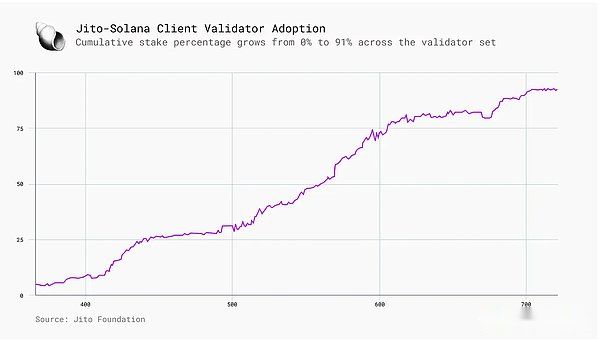
JitoSOL’s deposits have grown to 14.5 million SOL (approximately $3.14 billion), and have incurred $644 million in fees to date.JitoSOL’s position in Solana’s liquidity staking sector has steadily increased, currently accounting for about 45% of the total TVL.
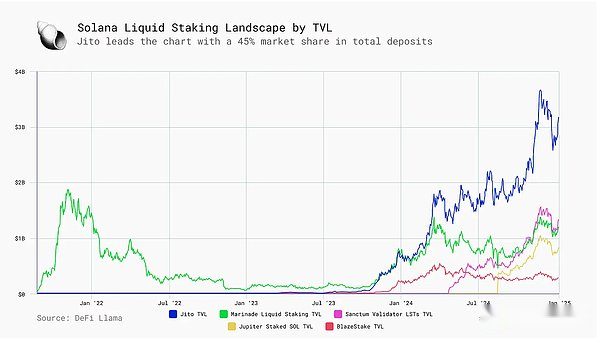
Demand to lend to JitoSOL on Kamino Finance continues to grow with utilization rates approaching 100%.
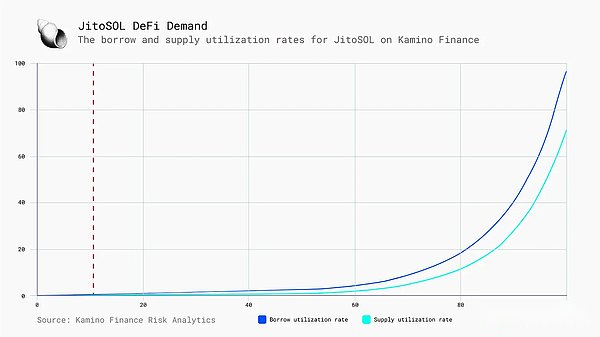
Jito (Re)staking’s competitive landscape
Despite Jito’s widespread presence in Solana, there are many critical catalysts and protocols that pose a credible challenge to the adoption of Jito (Re) staking.First, there is already another restaking agreement on Solana, Solayer, which was launched in June 2024 and has accumulated up to $168 million in deposits.Solayer has a restake architecture and a shared validator network designed to provide enhanced functionality for Solana applications to protect block space and prioritize transaction inclusion.
Second, Solana also faces competition from other native teams, especially liquid staking agreements, which may be in a good position and have the incentive to build their own restaking products.For example, Sanctum positioned itself as a unified liquidity layer for Solana LSTs, allowing all LSTs, large and small, to share a deep liquidity pool and operate with minimal liquidity constraints.So far, Sanctum’s Reserve, Infinity and Validator LST have attracted more than $1 billion in TVL.Helius, a core RPC provider on Solana, has launched their hSOL LST with Sanctum, which currently has over 13 million SOLs pledged.Binance’s BNSOL is currently in a leading position, with the SOL pledged on the platform being 6.77 million.Another notable Solana native competitor is Marinade Finance.Marinade launched its liquid staking agreement back in 2021, with current TVL slightly above $1.8 billion and lifetime expenses of $181 million.Although neither team currently mentions re-staking, it is not out of reach to imagine these teams developing their own competitive re-staking products.The launch of Karak seems to have opened the floodgates for restaking competitors on Ethereum, and similar effects are likely to be played out on Solana.
Finally, if universal resecurity protocols such as Symbiotic and Karak choose to adopt a chain-neutral approach that supports SOL and SPL/Token2022 assets, they will face competition.Even Eigenlayer has begun changing its strategy, introducing permissionless token support, which will allow any ERC-20 assets to be resolidated.However, from the perspective outside Ethereum, Eigenlayer ultimately positioned itself as the “innovation coordination engine”.If application development and value accumulation on Solana one day surpasses Ethereum, then there is no reason Eigenlayer doesn’t adapt to demand and open a store on Solana in this case.However, this is a long-term hypothetical scenario that cannot guarantee that Eigenlayer will always be the leading re-mortgage agreement, so it is unclear how much threat it poses to Jito (re-mortgage).
Against this background, Jito needs to rely on its successful record in the Solana ecosystem and ensure that the Jito Foundation continues to optimize the resolution agreement and promptly respond to the needs and feedback of NCN, operators and other protocol participants.
Jito (Re)staking application scenarios
Restaking protocols benefit from the increase in middleware solutions that require coordination mechanisms to meet business needs.NCN is still in its early stages and may cover multiple areas.The following are potential application scenarios for Jito (Re)staking:
•Decentralized solver network:
DEX and liquidity platforms with solver architecture can launch their own decentralized solver networks, allocate revenue and impose cuts on solvers, incentivizing them to execute transactions at the best price.
•SVM L2:
As Solana applications increase demand for faster block confirmation times and customized economic incentives, SVM L2 is gradually emerging, driving the growth of demand for economic security, where Jito (Re)staking can meet the demand.
•Order Flow Auction and MEV Redistribution Agreement:
Solana DEX can implement order flow auctions and allocate the value obtained through MEV to traders or token holders, similar to CoWSwap on Ethereum.
in conclusion
Although there are still significant gaps in the re-staking field from conception to reality, it is generally believed that re-staking will be a key development direction to promote the vigorous development of on-chain applications and help enhance its economic security and capital efficiency.It can be compared to the impact of Amazon Cloud Services (AWS): By providing a cloud computing platform that rents computing resources on demand, AWS has promoted the rapid rise of web application development.
By outsourcing computing resources and infrastructure construction, web developers can devote more time and resources to creating valuable products and services, and better understand user needs.Similarly, the re-staking protocol enables blockchain-native applications and networks to outsource economic security issues, thus focusing on developing valuable products and services while inheriting the key features and advantages of blockchain.
Restaking on Solana is on the rise, and Jito (Re)staking has a good position to become the preferred agreement to drive the launch of new innovative products and services.


